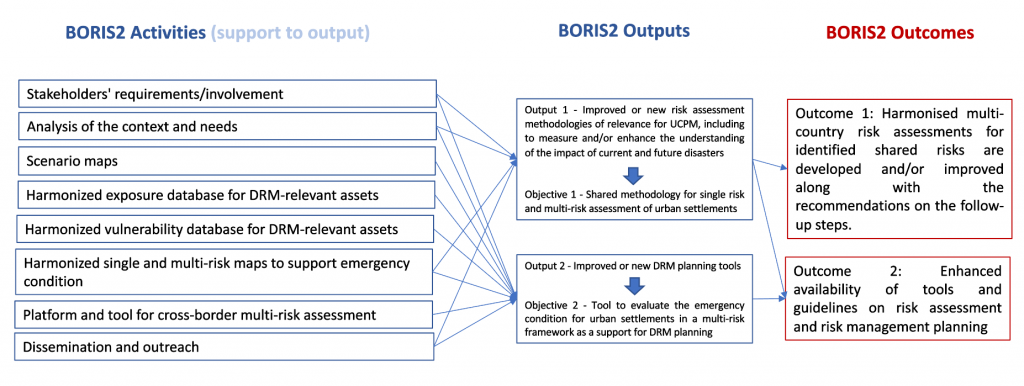BORIS2 is organized in 6 work packages:
WP1 – Project management (M1-24)
WP2 – Analysis of the context and needs assessment (M1-12)
WP3 – Platform and tool for cross-border multi-risk assessment (M6-22)
WP4 – Harmonized framework for urban multi-risk assessment (M3-15)
WP5 – Pilot applications in multi-country and cross-border sites (M12-24)
WP6 – Dissemination and stakeholders engagement (M1-24)
In WP2 – Context analysis and needs assessment, available data, processes, planning actions, policies and legal and institutional arrangements adopted in different countries to support the DRM at the urban scale in a single and multi-risk perspective will be analysed. Considering procedural frameworks and barriers, as also expressed by stakeholders in different countries (suitably engaged in WP6), WP2 will tackle obstacles and specific needs as well as procedural requirements to assess the efficiency of urban systems under emergency conditions.
The outcome of WP2 establishes a baseline for developing the WP4 – Harmonized framework for urban multi-risk assessment and WP3 – Platform and tool for cross-border multi-risk assessment that shall operate such a framework. Based both on the analysis of needs and requirements and on goals and target values expressed by stakeholders (WP6), WP4 will provide a harmonized framework and methodology for urban multi-risk assessment. Besides allowing to evaluate the most impacted areas by single and multiple risks in an urban settlement, such methodology will allow to assess the physical efficiency of the emergency system of urban settlements, to support effective emergency planning.
The methodology developed in WP4 will be applied in WP5 – Multi-country and cross-border pilot applications . The pilots will be demonstrated via the web-platform, developed in WP3 as an improvement of existing BORIS platform. The web-platform will be equipped with simulation tools, allowing to provide results of alternative seismic, flood or multi-risk scenarios and to visualize resulting maps for effective sharing and dissemination of results.
The WP6 – Dissemination & Stakeholder engagement ensures that Stakeholders are involved in the platform co-design and in its evaluation and testing; moreover, WP6 will increase dissemination reach through UCPKN platform features, such as stories and discussion fora, that will be used together with other media channels to increase the project results visibility.
Outputs and outcomes
As main results, BORIS2 will deliver a shared methodology for single risk and multi-risk assessment of urban settlements (Objective 1), which will be applied to three pilot applications at Italy-Slovenia and Austria-Slovenia borders, and in Montenegro. Also, it will deliver a tool to evaluate the emergency condition for urban settlements in a multi-risk framework as a support for DRM planning (Objective 2), that will be implemented in the updated version of the BORIS web-platform. Exposure and vulnerability data collected at pilot sites are used to perform the single and to multi-risk assessment according to the shared methodology. Data and results are stored and shared in the new platform, that shall become a mean to represent risk in a DRM perspective in a common framework. Stakeholders, such as civil protection organizations at the national, regional or local level, local administrators and scientific experts will be directly engaged at the different stages of the project to co-design and test the platform accoding to specific need and observations. The possibility to visualize (through the web-platform) risk results for different scenarios and the functionality of emergency system after damaging event will facilitate emergency planning for an enhanced preparedness.

If you would like to access the BORIS2 deliverables, please visit the project website on the UCPKN platform which will be updated regularly:
